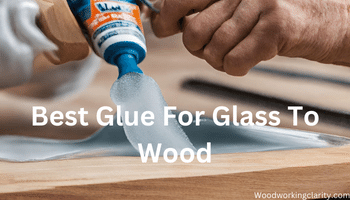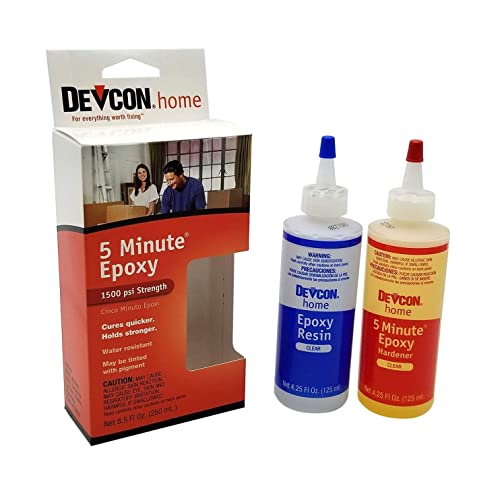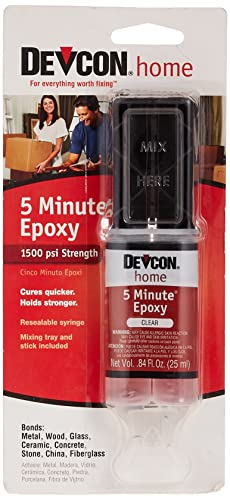Finding the perfect glue for the unique task of bonding glass to wood can be a challenge. After extensive testing and a multitude of projects, one clear standout emerged from the pack: Devcon 8.5oz 5 Minute Epoxy.
With years of hands-on experience in woodworking, I’ve navigated the complexities of adhesive choices. This epoxy delivered exceptional results.
In this guide, I’ll delve into why Devcon’s 5-Minute Epoxy reigns supreme. I’ll also explore its unparalleled versatility and reliability.
So, join me as I unlock the nuances of this and other remarkable adhesives in the market. Read on to discover the ideal companion for your project if you’re seeking an adhesive that combines speed, strength, and dependability.
Our Top Picks
Best Glue For Wood to Glass
- Top Pick – Devcon 8.5oz 5 Minute Epoxy
- Best Bang for the Buck– Krazy Glue
- Most Resilient and Durable Glass Glue – Loctite Epoxy
- Most Versatile Glass Glue – PC Products PC-Super Epoxy
- Best Water-resistant Glue – Gorilla Clear Glue
- Most Convenient – ITW Devcon 20845
- Fast Setting Glass Glue – J-B Weld 8276 KwikWeld
When choosing the best adhesive for glass to wood, consider its reliability, durability, and aesthetics. This will ensure that you achieve the expected results from the adhesive.
Here are some of the best products I highly recommend in the market.
1. Top Pick – Devcon 8.5oz 5 Minute Epox
- Devcon 9oz 5 Minute Epoxy 1500lb Waterproof Glue 4.5oz
- Epoxy High Strength Bonding 1500 psi
- Sets in 5 Minutes
The Devcon 8.5oz 5 Minute Epoxy is the unrivaled champion for bonding glass to wood. My hands-on experience with this remarkable adhesive has solidified its position at the top.
Its exceptional strength sets it apart, boasting a staggering 1500 psi bonding capacity. When it claims to set in just 5 minutes, it means business.
During my tests, it delivered rapid, rock-solid bonds that left no room for doubt. This epoxy also proves its versatility and unwavering reliability.
Additionally, it resists various chemicals. For this reason, it stands up to the challenges of diverse applications.
Now, while it may come with a higher price tag than some glues, its value is undeniable. The peace of mind knowing that your glass-to-wood bonds will withstand the test of time and maintain their integrity is priceless.
This epoxy glue is a bit expensive, but it’s worth it. It’s great for sticking wood to other things and lasts long. If you need strong glue, this is the best choice.
What I Liked Most
- It is an all-purpose epoxy adhesive.
- It forms a powerful and reliable bond
- Sets quickly in about five minutes.
- Resists water and man chemicals.
- Easy to use and store.
- Dries clear.
What Could Be Improved
- Mixing the epoxy resin with the hardener requires you to get the perfect ratio.
- It allows for a short working time upon mixing the components.
2. Best Bang for the Buck– Krazy Glue
- Glue maximum bond
- Brand of the product is Krazy
- Manufactured in japan
In the realm of adhesive supremacy, the Krazy Glue secures its place at the second pinnacle. This alternative is mindful of budget.
While the Devcon epoxy impresses with its formidable bonding strength and versatility, the Krazy Glue Max Bond offers a unique value proposition as the best budget option.
The Krazy Glue Max Bond may not reach the same stratospheric bonding strength as its counterpart. But, it excels in precision and versatility.
The extended precision tip allows for pinpoint application. Meaning, you will get the right amount of adhesive exactly where you need it.
This feature is valuable when working with delicate materials like glass. Furthermore, the Krazy Glue Max Bond is a quick performer, setting within minutes.
While it may not match the Devcon epoxy’s sheer strength, it fills a gap by providing an affordable option. That’s perfect for a multitude of everyday projects, especially when you need precision and a quick fix.
The Krazy Glue Max Bond offers excellent value for its price point. If your needs align with its attributes, it stands as a budget-friendly alternative that doesn’t compromise on quality.
3. Best Resilient and Durable Glass Glue – Loctite Epoxy
- Easy-to-use self-mixing dispenser and precision applicator
- High-strength formula bonds wood, metal, tile, ceramic, glass, plastic and more
- Waterproof, sand able and paintable
I have been using Loctite Epoxy instant mix for over 50 years, and it’s a reliable two-part adhesive that includes an epoxy resin and hardener.
I need to get two things, the resin and the hardener. Mix them together in equal amounts. Wait 5 minutes, and then it will be strong.
This glass-to-wood glue comes with a precision applicator and self-mixing dispenser that makes it easy to use. Plus, its high-strength formula allows me to bond broken glass, wood, tile, metal, plastic, and more together.
I can also use this adhesive on a wide range of materials or as a filler for gap bonding and surface repairs. This material does not get smaller, it does not get wet easily, and you can sand it, paint it, or add color to match other things.
The static mix nozzle ensures a uniform mixture of resin and hardener every time I use it. With Loctite, I can trust that my project will stay together for many years.
What I Liked Most
- It doesn’t shrink
- Versatile for a variety of surfaces
- It’s durable and reliable
- Water-resistant
What Could Be Improved
- It takes a long time to cure
- It’s quite expensive
- It doesn’t suit large projects
4. Best Value For Your Money – PC Products PC-Super Epoxy
- Epoxy adhesive paste bonds, seals, and fills a range of materials, including wood, metal, glass, brick, concrete, and fiberglass
- Cures translucent to blend in with bonded material
- Continuous service temperature range from -20 to +200 degrees F
If you’re looking for an easy-to-use glue that adheres well with super strength, then PC-Super Epoxy is the way to go. I can use it for wood and glass projects and metal, brick, fiberglass, and concrete.
This two-part epoxy paste is flexible and versatile, offering unmatched strength and a 5-minute working time.
The non-drip epoxy paste is strong and can resist mild acids, detergents, fuel oil, caustics, and fresh or salty water. If the glue needs to be cold or cool, put it near something that gives off the heat before you use it.
This adhesive is easy to spread and use at 80 degrees Fahrenheit. It can be used in temperatures from -20 to +200 degrees Fahrenheit.
After sticking glass, I can drill, sand, saw, or paint the epoxy resin after it cures. Plus, it blends with the surface I’m working with due to its translucent curing. All this makes PC-Super Epoxy the perfect choice for my projects.
What I Liked Most
- It is affordable.
- The injector is convenient to use.
- It offers unparalleled chemical resistance.
- Forms a durable bond.
- Versatile enough for various materials.
- It doesn’t emit fumes.
What Could Be Improved
- It doesn’t offer great coverage, especially for large surfaces.
- It doesn’t dry ultra-clear.
5. Best Water-resistant – Gorilla Clear
- Crystal clear
- Non-foaming
- Water resistant
I love Gorilla clear glue for my various crafting or repair needs. Unlike other epoxy adhesives, this product doesn’t require a hardener and dries to a crystal-clear residue – perfect for any project type.
The bottle has a special cap that makes sure the stuff inside does not dry out and blocks the nozzle. It also has a pointed tip, so you can be more precise when using it.
I can use it on wood, glass, metal, fiberglass, and concrete – giving me the freedom to experiment with different materials. Plus, I don’t have to wait long for it to dry; it only takes about 2 hours.
I always remember to clamp my project after application for better adhesion. All in all, Gorilla glue is a reliable option that I can count on for any of my projects!
What I Liked Most
- It’s water-resistant
- It’s an affordable option
- Easy to use
- Dries clear
- Doesn’t foam
What Could Be Improved
- Requires clamping while drying
6. Most Convenient – ITW Devcon 20845
- Bonds rigid durable substrates such as metals, glass, ceramics, concrete and wood in all combinations
- Forms a clear hard rigid bond self leveling liquid in minutes
- Functional strength in 1 hour
I can use ITW Devcon Epoxy to bond different surfaces together, such as metals, wood, glass, ceramics, and concrete.
This self-leveling glue dries crystal clear and sets in 1 hour with reliable strength. With its low viscosity of 10,000 cps, I get great coverage for gluing large projects.
The non-drip formula is ideal for vertical surfaces like mirrors. I can as well use it to fill cracks and voids in wood, concrete, and metal.
When I’m using the epoxy, I need to mix only the resin and hardener that I need within the handling time and make sure there’s an equal portion of each.
I then need to mix the contents, and if I want to add color pigments concentrate, I can do so after ensuring a thorough mixture. This ensures that the product cures.
What I Liked Most
- It self-levels
- It features a low viscosity
- Works with a variety of surfaces
- Dries crystal clear
What Could Be Improved
- It takes a long time to cure
- Requires thorough mixing
7. Fast Setting Glass Glue – J-B Weld 8276 KwikWeld
- J-B Weld Kwikweld: A Fast Setting Version Of The Original Cold Weld Two-Part Epoxy System That Provides Strong, Lasting Repairs To Multiple Surfaces. Perfect For Diy Household, Automotive, Marine, Craft Repair And Much More
- Cure And Set Time: After Mixing The Tubes At A 1: 1 Ratio, It Takes 6 Minutes To Set And 4-6 Hours To Cure. Once Cured, Kwikweld Can Be Tapped, Filled, Sanded, Molded And Drilled. Kwikweld’S Set And Cure Color Is Dark Grey
- Versatile And Dependable: J-B Weld Kwikweld Is Steel Reinforced, Has A Tensile Strength Of 3127 Psi And Can Withstand Temperatures Up To 230 Degrees Fahrenheit (110 Degrees Celsius). When Fully Cured, Kwikweld Is Waterproof And Resistant To Petroleum, Chemical And Acid
J-B Weld continues the legacy of exceptional performance. KwikWeld doesn’t just provide strong and lasting repairs, it is quick to dry.
Once you’ve mixed the tubes at a 1:1 ratio, it takes a mere 6 minutes to set. Within 4-6 hours, it fully cures, transforming into a robust and durable bond.
Moreover, KwikWeld is nothing short of versatile and dependable. With steel reinforcement and a tensile strength of 3127 psi, it can withstand substantial loads and stresses.
Its ability to endure temperatures of up to 230 degrees Fahrenheit further adds to its resilience. Once cured, KwikWeld becomes waterproof and resistant to petroleum, chemicals, and acids.
The surface applications for KwikWeld are limitless. This versatility ensures that it’s a one-stop solution for numerous repair and bonding needs.
Whether you’re embarking on DIY projects or tackling professional repairs, KwikWeld’s quick setting, durability, and adaptability make it an invaluable addition to your toolkit.
How To Glue Glass to Wood
When you’re sticking glass to wood, it’s all about keeping things smooth, without any bubbles or streaks.
Start by making sure both the glass and wood are clean. If the wood’s got cracks or chips, fill them in. Sand it down if it’s painted or stained, so the glue sticks better.
Now, for the glue, you want something clear and tough. If it’s got a hardener, mix it well. Apply the glue carefully along the edges where you’re joining the glass to the wood. The trick is to be precise but not too heavy-handed.
Press the glass onto the wood, holding it steady for a minute or so. If it’s a big piece, you might need clamps or tape to keep it in place. Give it a day to dry completely. That’s 24 hours.
After it’s dry, if you see any extra glue sticking out, just scrape it off gently. Use a razor blade or a glass scraper, but be careful not to scratch the surfaces. That’s pretty much it. It’s all about being neat and patient. The result? A clean, professional look that lasts
Gluing Wood to the Glass Using Liquid Nails
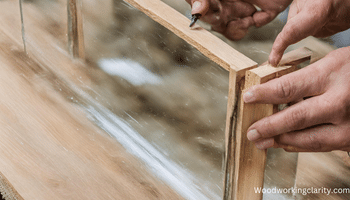
Liquid nail glue exists in two types, including;
- Organic soluble- This type of liquid nail glue dries and adheres well. Moreover, it can withstand temperatures up to -40°C.
- Water-soluble- While it’s suitable for joining porous surfaces, avoid using it for projects prone to water exposure.
Steps for using liquid nails to glue glass and wood
- Clean the wood and glass surfaces to get rid of dirt and dust.
- Treat both surfaces using a degreaser.
- Apply glue to the glass surface using a stripe or dot-like pattern.
- Attach the glass to the wood, and apply slight pressure. You can also use a small weight to compress them together.
- Hold the surfaces together using a clamp or rubber bands until the drying time elapses.
Take the necessary precautions when working with liquid glue, especially the organic soluble liquid nails.
Types Of Wood to Glass Glue
First up, epoxy glue. This one’s tough. It sets in about five minutes, but give it a full day to hold tight. It’s strong and sticks to almost anything, but watch out, it’s a bit tricky to mix and can be nasty stuff if you’re not careful.
Then there’s superglue, or what they call cyanoacrylate. It dries super fast, great for quick fixes. But for bigger jobs, it might not be your best bet. It’s not great as a filler, so make sure those surfaces are smooth and ready.
Silicone glue is your go-to for outdoor stuff. It’s weatherproof glue and sticks well, even in heat. Plus, it comes in handy sizes, whether you’re doing a small job or a big one.
Polyurethane glue is like epoxy. It’s strong, good for filling gaps, and works indoors and out. It expands as it dries, so a little goes a long way.
UV adhesive is a bit special. It sets fast under UV light, but it’s not for every wood type, so check before you use it.
Lastly, liquid nails. This one’s versatile, especially for covering larger areas.
So, there you have it. Each glue has its own strengths. Pick the one that fits your project and you’re good to go.
Safety Precautions
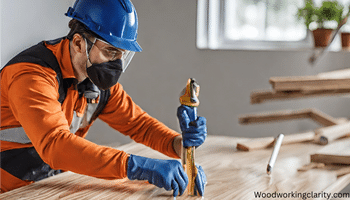
- Wear the correct protective equipment, including gloves and goggles. Also, if you’re working with glues in liquid form that produce fumes, you’ll need a respirator mask.
- When not in use, store the glue in an airtight container or its original bottle. Besides keeping the toxic fumes at bay, it will ensure that the glue doesn’t dry.
- Use small quantities of glue instead of spreading large amounts at a time.
- Painting glass window after gluing. Glue can affect the adherence of paint to the glass surface and may result in an uneven or unsatisfactory finish
- Ensure you are in a well-ventilated area or working outdoors to prevent inhaling toxic glue fumes.
3 Glues Types to Avoid
First off, steer clear of PVA glue. You know, the white glue you might’ve used in school or for woodworking. It’s great for paper or plain wood, but with glass? Not so much. It doesn’t stick well and tends to peel off after it dries.
Next up, hot glue. It’s a go-to for quick crafts, sure, but when it comes to glass and wood, it’s a no-go. Hot glue doesn’t bond well with glass and can get weak with temperature changes. So, what sticks today might not stick tomorrow.
Last one to avoid is standard construction adhesives. These are the heavy-duty glues for big, porous materials. But for glass? They’re just too thick and stiff. They don’t flex well, so the bond they make with glass is often weak and unreliable.
So, when you’re picking glue for glass and wood, think about what you need. Skip these three, and go for something like epoxy, silicone, or UV-curing adhesives. They’ll give you a much stronger, lasting bond.
FAQs
How to attach glass to wood frame
You can attach glass to a wood frame using silicone. First, make sure that the surface of the wood frame is clean and dry. Then, apply a thin silicone coat to the glass’s edge, and press it firmly against the wood frame. Due to contractions and expansion, the wood may crack ( See our guide for repairing door frames with wood filler).
Does wood glue work on glass?
Yes, wood glue will work on glass, although it’s not the best choice. Glass is a non-porous surface, so a glue such as epoxy would be better suited to the task. Wood glue is a good option if you don’t have any epoxy on hand, but it has the potential to weaken over time.
How to glue wood to a glass mirror
Glue wood to a glass mirror using a strong bond between the surfaces like silicone adhesive. Another option is to use an epoxy adhesive to form a strong bond and be moisture-resistant. Whichever method you choose, ensure the surfaces are clean and dry before beginning the gluing process.
Final verdict
In our quest to find the perfect adhesive for the delicate task of bonding glass to wood, we’ve journeyed through various options. At the end of this exploration, one product, Devcon 8.5oz 5 Minute Epoxy, has emerged as the champion.
Its rapid curing, unwavering strength, and versatility make it the top choice for a multitude of projects. Whether you’re a seasoned craftsman or an avid DIY enthusiast, Devcon’s epoxy offers an ideal blend of efficiency and reliability.
It bridges the divide between glass and wood, ensuring secure bonds in your creations. Ready to elevate your projects? Choose Devcon Epoxy and embark on your next glass-to-wood endeavor with confidence.

